Open the analysis dialog box: - Click Porcupine Curvature Analysis

The Porcupine Curvature dialog box appears.
- In the Porcupine Curvature dialog box click More....
The dialog box expands to reveal all its options.
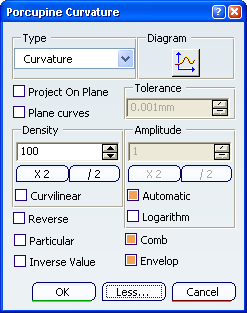
View the comb analysis on a surface and then on a curve: - Select a surface in the 3D area.
- If you select the surface, the porcupine comb shows the curvature on each boundary of the surface.
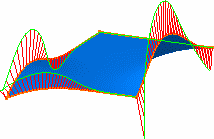
- If you select a specific boundary, the comb is displayed
only on this boundary.
Ensure the Geometrical Element
Filter selection mode is active from the User Selection
Filter toolbar (this mode lets you select sub-elements).

- Select a curve in the 3D area.
The porcupine comb shows the curvature of the curve.
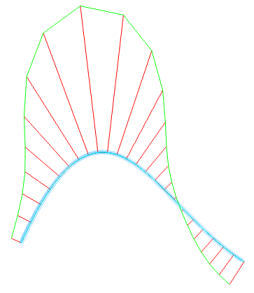
- In the Type area of the dialog box, select Radius.
The porcupine comb now shows the radius of the curve.
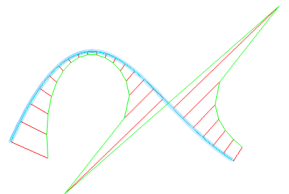
Adjust the characteristics of the porcupine comb: - In the Type area of the dialog box, select Curvature.
- In the Density area of the dialog box, adjust the number of spikes in the comb by using the arrows in the spin box or by clicking X2 and /2.
In this example the density of the spikes has been increased.

- In the Amplitude area of the dialog box, clear the Automatic check box and then adjust the length of the spikes in the comb by using the arrows in the spin box or by clicking X2 and /2.
In this example the amplitude of the spikes has been decreased.
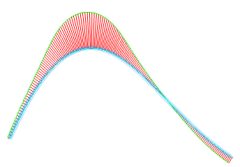
Notes:
- Adjusting the density of the spikes is particularly useful when the geometry is
too dense to be read but the resulting curve may not be smooth
enough for your analysis needs.
- When Automatic amplitude is selected, the length of the spikes
is optimized so that even when zooming in or out, the spikes are always visible.
Use the Particular option to display the minimum and the maximum points.

You can right-click on any of the spikes and select Keep this Point to keep the current point at this location.
A Point.xxx appears in the specification tree.
If you select the Particular option, you have access to more
contextual commands:
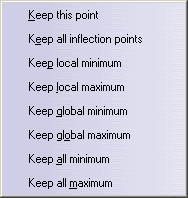
View a curvature diagram: - In the Diagram area of the dialog box, select Display diagram window
 . .
The 2D Diagram dialog box appears. The curvature amplitude and parameter of the analyzed curve
are represented in this diagram.

When analyzing a surface or
several curves,
you can use different options to view the analyses.
For example, when analyzing a surface, by default you obtain
this diagram, where the color of the curves in the 2D Diagram dialog box match the ones on the geometry.
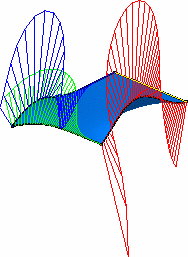
- Move the cursor over the porcupine comb in the 3D area.
The local amplitude is displayed and the current location is displayed in the 2D Diagram dialog box.
- Right-click a curve in the 2D Diagram and choose one of the following
options:
- Remove: removes the curve.
- Drop marker: adds Points.xxx in the specification
tree.
- Change color: displays the Color selector
dialog box that enables you to change the color of the curve.
- When you have finished with the 2D Diagram, click the x in the top right corner to close.
When you have finished working with this command, do one of the following: - To create the analysis, click OK.
The analysis is added to the specification tree where it is identified as Command_Name.Analysis.x. The analysis will be updated automatically whenever you modify any of the elements in the analysis (for example when you deform an element using control points).
- To abandon the analysis, click Cancel.
Notes:
- The Reverse analysis is opposite to that which was initially displayed.
This is useful when, from the current viewpoint, you do not know
which way the curve is orientated.
- Project on Plane option applies a curvature
signature due to the curvature analysis projection.
- In case of clipping, you may
want to temporarily modify the Depth Effects' Far and
Near Limits. See Setting Depth Effects in
Infrastructure User Guide.
|










